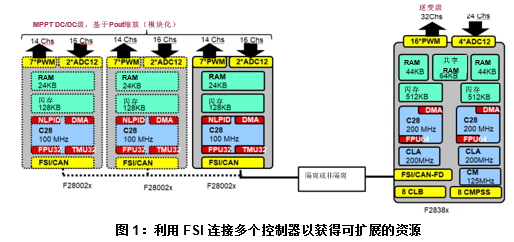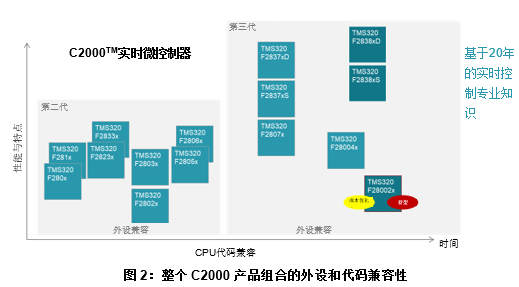In the real-time power conversion field that continues to demand higher performance and efficiency, it is critical for designers to invest in scalable and sustainable industrial and automotive power conversion solutions. This demand in turn leads to the demand for real-time control system resources, such as the number of MCUs with millions of instructions per second (MIPS) computing power, pulse width modulators (PWMs), and analog-to-digital converters (ADCs) in servo drive systems, power and grid infrastructure, and on-board charging applications. This also leads to the need for developers to build and maintain their product lines in a simple and low-risk manner. Performance scalability and product portfolio compatibility provide developers with a labor-saving and cost-effective way to expand real-time control resources and maintain a platform for long-term power conversion solutions.
Scaling real-time control resources through distributed architecture
The rise of renewable energy sources has driven the use of higher power levels in applications such as solar inverters. As power levels increase, more real-time control resources such as MIPS, PWM, and ADC are needed, which play a vital role in the power conversion process. The typical approach to addressing this demand is to control multiple power stages in a solar inverter system through a single central controller. What happens when this controller is not resourceful enough to address higher power levels and an increasing number of power stages? Distributed architecture is the best solution to this problem.
The idea of a distributed architecture is to connect multiple real-time control MCUs to expand the number of available system resources and peripherals. This implementation enables designers to achieve the performance and efficiency required for their products without compromising product performance.
Cost of multi-chip solutions
The complexity of connecting multiple devices through isolation and interface speed
Lack of peripherals with external memory interfaces on the host/main processor
Texas Instruments' C2000 real-time control MCU portfolio addresses these three issues and realizes the true value of distributed power conversion architectures:
The latest version of Texas Instruments' C2000 real-time control MCU series, the TMS320F28002x series, is low-priced and can help designers optimize BOM costs through distributed architectures. The rich features in the C2000 real-time control MCU series, such as accelerators, configurable logic, analog comparators, and peripherals, can further optimize system architectures.
Fast Serial Interface (FSI) enables reliable and robust high-speed inter-chip or inter-board communication at speeds up to 200 MBPS. FSI offers advantages over other interface protocols such as CAN or SCI. The low speed and lack of slew rate compensation of CAN or SCI make them unsuitable solutions for connecting multiple MCUs for isolated communication. Due to the inherent slew rate compensation and speed of FSI, connecting multiple MCUs for resource scalability becomes a labor-saving and robust interface option. Figure 1 shows how FSI can be used to connect multiple real-time control MCUs for extended MIPS, PWM, and ADC in solar inverters and other applications.
The introduction of the Host Interface Controller (HIC) in the F28002x enables the MCU to act as a bridge, ultimately enabling the host processor to indirectly gain access to the FSI and other peripherals on the controller. Whether or not FSI is available on your host processor, the F28002x allows designers to achieve scalability through a distributed architecture.

Simplify migration and platform development through portfolio compatibility
In addition to resource scalability, designers are also faced with the challenge of building and maintaining product platforms. To achieve this effectively, a low-effort and low-risk approach is required to build product lines from high-end to mid-range to low-end.
The C2000 real-time control MCU portfolio provides peripheral and code compatibility across device families, reducing the workload of developers using multiple products. This simplifies the process of migrating and building products based on similar MCU technology, thereby achieving sustainable platform solutions. Figure 2 shows the pin-to-pin, peripheral and code compatible device family in the third generation of C2000 real-time control MCUs – from high-end to mid-range to low-end products.

In the evolving automotive and industrial power conversion markets, designers are looking for innovations that can help them address two key design challenges: how to easily scale real-time control resources, and how to build and maintain long-term platform solutions. Connecting multiple C2000 real-time control MCUs through FSI to achieve scalable MIPS, PWM, and ADC in applications such as solar inverters and distributed multi-axis servo drives is an efficient, low-risk, and cost-effective solution for scalable real-time control resources. At the same time, code and peripheral compatibility of device families in the C2000 portfolio makes it possible to develop efficient, low-risk, long-term platforms. The F28002x device family not only provides a cost-effective way to scale real-time control resources through a distributed architecture, but is also compatible with the existing C2000 portfolio, enabling designers to build long-term, sustainable solutions.
Previous article:Technical Articles - Three Powerful Weapons to Eliminate EMC: Capacitors/Inductors/Magnetic Beads
Next article:Challenges in power supply design: Mouser Technology Innovation Week 2 begins
- MathWorks and NXP Collaborate to Launch Model-Based Design Toolbox for Battery Management Systems
- STMicroelectronics' advanced galvanically isolated gate driver STGAP3S provides flexible protection for IGBTs and SiC MOSFETs
- New diaphragm-free solid-state lithium battery technology is launched: the distance between the positive and negative electrodes is less than 0.000001 meters
- [“Source” Observe the Autumn Series] Application and testing of the next generation of semiconductor gallium oxide device photodetectors
- 采用自主设计封装,绝缘电阻显著提高!ROHM开发出更高电压xEV系统的SiC肖特基势垒二极管
- Will GaN replace SiC? PI's disruptive 1700V InnoMux2 is here to demonstrate
- From Isolation to the Third and a Half Generation: Understanding Naxinwei's Gate Driver IC in One Article
- The appeal of 48 V technology: importance, benefits and key factors in system-level applications
- Important breakthrough in recycling of used lithium-ion batteries
- LED chemical incompatibility test to see which chemicals LEDs can be used with
- Application of ARM9 hardware coprocessor on WinCE embedded motherboard
- What are the key points for selecting rotor flowmeter?
- LM317 high power charger circuit
- A brief analysis of Embest's application and development of embedded medical devices
- Single-phase RC protection circuit
- stm32 PVD programmable voltage monitor
- Introduction and measurement of edge trigger and level trigger of 51 single chip microcomputer
- Improved design of Linux system software shell protection technology
- What to do if the ABB robot protection device stops
- Detailed explanation of intelligent car body perception system
- How to solve the problem that the servo drive is not enabled
- Why does the servo drive not power on?
- What point should I connect to when the servo is turned on?
- How to turn on the internal enable of Panasonic servo drive?
- What is the rigidity setting of Panasonic servo drive?
- How to change the inertia ratio of Panasonic servo drive
- What is the inertia ratio of the servo motor?
- Is it better for the motor to have a large or small moment of inertia?
- What is the difference between low inertia and high inertia of servo motors?
- The STM8S003 program disappears easily
- (nand) sd boot
- EEWORLD University Hall----Live Replay: Introduction and Application of C2000? Built-in Programmable Logic Module CLB
- [EEWorld invites you to play disassembly] —— A brief analysis of Baseus GaN charger 45W/65W
- What is the principle of RC filter circuit? What is going on?
- Using TL431 for constant current output
- IAR opens CC1310 SDK and reports an error
- 【CH549 Review】Part 2 Programming Tool Review
- Can UART1 and SPI of C8051F340 work at the same time?
- The water pump stops accidentally

 Three-Phase 11 kW PFC + LLC Electric Vehicle On-Board Charging (OBC) Platform User Manual (ONSEMI Semiconductor)
Three-Phase 11 kW PFC + LLC Electric Vehicle On-Board Charging (OBC) Platform User Manual (ONSEMI Semiconductor) 518 Questions on Automotive Electrical Maintenance_2nd Edition
518 Questions on Automotive Electrical Maintenance_2nd Edition
















 京公网安备 11010802033920号
京公网安备 11010802033920号